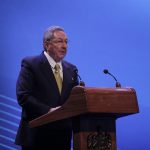Not by chance, October 20 was chosen as the Day of the Cuban Culture. I remember with how much pride Armando Hart reiterated the importance that the date on which the Bayamo Hymn was sung for the first time served to pay tribute to the men and women who are the protagonists of the country’s cultural life. Thus, Hart said, the organic identification between our creators and the patriotic, anti-slavery and anti-colonial ideals of 1868, enriched later by Martí, Mella, Guiteras, Fidel, had been synthesized in an excellent way.
The triumphant Revolution in 1959 received enthusiastic support from the overwhelming majority of Cuban artists and writers. Many, even, who lived abroad, returned to the Island to join in the construction of a new world.
Although the aggressiveness of the US began very early, through pressure and threats, attacks, bombings, financing of armed gangs and a fierce media campaign, the revolutionary government did not neglect the promotion of culture: it founded the Icaic, the Casa de las Américas, the National Printing Office and the first school of art instructors, and carried out the Literacy Campaign.
According to Carpentier, the times of solitude had ended for the Cuban writer and those of solidarity had begun. And it is that the Revolution formed a massive and avid public for the arts and letters. It also gave space to the most genuine and discriminated expressions of popular traditions and to the most audacious searches in the various artistic genres.
Unable to perceive the deep links between culture and the Revolution, the Yankees insisted on organizing groups of “dissidents” in the intellectual circles; but they failed again and again.
The case of Armando Valladares was the result of desperation: he was exhibited before the world as an invalid poet prisoner of conscience. They even published a book of poems with great publicity and a dramatic title: From my wheelchair. But he was neither a poet nor a paralytic (he nimbly climbed the plane’s ladder when he was pardoned), he had a murky past as a police officer under the Batista tyranny and had been sanctioned for terrorist activities.
Now, many years later, they present an alleged “movement” (San Isidro), an alleged rapper prosecuted for contempt, and an alleged hunger strike by a dozen alleged “young artists.” They were backed by a strong campaign in the foreign press, in digital media paid for subversion, and on social media. They had the immediate support of Pompeo, Marco Rubio, Almagro and other characters.
Through social networks, a rarefied climate was created, with an intense emotional charge, to elicit expressions of adherence and moral support in the face of a hypothetical injustice.
As has been studied by many analysts, appealing to emotions in the networks engulfs people in transitory sentimental communities, and paralyzes the ability to reason, judge and verify where the limits are between reality and fiction.
Many (most) of those who gathered on November 27 outside the doors of the Ministry of Culture were influenced by the atmosphere created on the networks. Few knew what actually happened in San Isidro and its protagonists. Perhaps some of them had had one or another bad experience and felt hurt. I think they honestly wanted to dialogue with the institution.
Others (a minority) participated with total conscience in a plan against the Revolution. They used social networks to amplify what was happening there and spread it in an adulterated way. Fake news was rolled out around an imaginary crackdown that included tear gas, pepper spray and alleged ambushes against participants. They knew they were helping to justify Trump’s policies against their country with lies. They were only interested in the “dialogue” to turn it into news, into a show, and score it as a victory. Some needed to justify the money they receive.
However, it is necessary to clearly separate the cartoon from the marginals of San Isidro and what happened in the Ministry of Culture. In the second case, there are valuable young people who must be cared for.
The cultural policy of the Revolution has opened a wide and unprejudiced space for creators to be able to do their work in total freedom. It is true that there have been errors, misunderstandings and blunders, but the revolutionary process itself has been in charge of rectifying them.
The institutions, together with Uneac and the Hermanos Saíz Association, remain open to frank debate with artists and writers. If for some reason the dialogue is interrupted, there are appropriate communication channels to resume it.
It is totally legitimate to discuss how to consolidate the links between creators and institutions, about experimental manifestations of art that have not yet been sufficiently understood, about the essential critical function of artistic creation, about the “anything goes” of the postmodern vision, about the freedom of expression and many other topics.
What is not legitimate is the disrespect for the law, the pretense of using blackmail against the institutions, outraging the symbols of the country, seeking notoriety through provocation, participating in actions paid for by the enemies of the nation, collaborating with those who work to destroy it, lie to join the anti-Cuban chorus in the networks, stir up hatred.
In the midst of the global crisis caused by the pandemic and global neoliberalism, Cuba is simultaneously suffering unprecedented harassment from the US. That is why this moment has been chosen to finance shows that offer a disfigured image of the country.
Any creator who approaches institutions with legitimate objectives will find interlocutors willing to listen and support him. With the phonies there is no possible dialogue.

Redacción Digital
Equipo de redactores del sitio web de Radio Mayabeque



